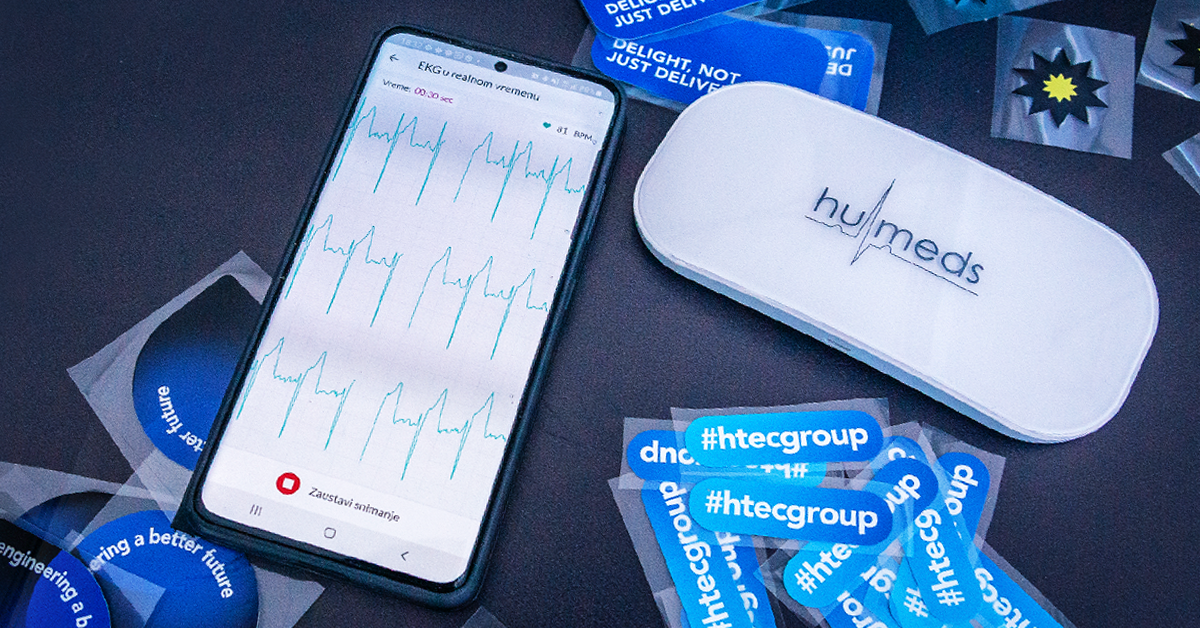
Humeds — The Story Behind Success
We talked with Srdjan Jovanovic, Director of People Operations at HTEC Group and leading engineer on the Humeds project, about how this unique product came to life, how it can impact the future of telehealth and improve people’s well-being globally. H: How did Humeds come to life?
S: HTEC Group was built on the foundation of great engineering and deep technology expertise. While developing state-of-the-art products for our customers, we wanted to invest our time and expertise in solving complex problems of humanity and increase people’s health and wellbeing — automated analysis of the ECG signal being one of them.
As opposed to the most common in-house diagnostic tools (blood pressure, blood sugar) where measurement analysis is based on the understanding where you are compared to the well-known thresholds, in ECG analysis it is required to have an expert that is trained and experienced in reading and classifying the ECG signal. This motivated HTEC to develop a set of algorithms, expert systems, and neural networks to achieve close to 99% accuracy when classifying signals, whether normal or arrhythmic.
H: Why did you decide to build a medical device?
In the process of collecting signals that would be used for training and testing of algorithms we were faced with the same problems that all people having heart issues are facing everyday – the complex usage process and very low diagnostic yield of a standard ECG holter unit. Namely, based on the study done by the US health system, only 27% of the signals that are collected with a standard holter have a diagnostic potential – the remaining 73% of the signals (patients) will have to either go again through the same process of scheduling and wearing a holter, or alternatively, use a Humeds-like device.
Together with the leading ECG experts in the region we designed a hand-held medical device that leverages the reliability and ease of use of dry electrodes. Humeds is a small factor device that can be carried in a pocket or a bag, but with sufficient size to allow us to collect, when applied to the chest, three different ECG leads (same as a holter) which is a golden standard in the ECG analysis.
After successfully completing clinical studies, gaining certifications and receiving a medical grade CE mark, we were able to match our algorithms with the device, mobile and web applications, and Cloud to build the entire Humeds ecosystem.
H: What was the main driver to success?
One of the reasons why HTEC Group is one of the most successful engineering companies is our ability to match in-house deep engineering expertise with domain knowledge coming from the field experts. This was the model that we applied to the development of Humeds medical system as well, which helped us focus on solving the real problems and getting the right questions (not just the answers) and ideas from the other side.
H: What are the next steps?
S: We finished all clinical studies that have shown the potential of the system, completed the certification process and got the CE mark and now we are in a process of piloting our solution with the state health system and private clinics at the same time. As a matter of fact, as you are reading this blog, Humeds is helping save lives globally.
You can read about Humeds and its impact in Netokracija’s article “Kako je domaći HTEC razvio Humeds – mobilni rekorder za precizniju dijagnozu srčanih aritmija”.
You can find out more details about Humeds on our site, or watch this video.
H: How did Humeds come to life?
S: HTEC Group was built on the foundation of great engineering and deep technology expertise. While developing state-of-the-art products for our customers, we wanted to invest our time and expertise in solving complex problems of humanity and increase people’s health and wellbeing — automated analysis of the ECG signal being one of them.
As opposed to the most common in-house diagnostic tools (blood pressure, blood sugar) where measurement analysis is based on the understanding where you are compared to the well-known thresholds, in ECG analysis it is required to have an expert that is trained and experienced in reading and classifying the ECG signal. This motivated HTEC to develop a set of algorithms, expert systems, and neural networks to achieve close to 99% accuracy when classifying signals, whether normal or arrhythmic.
H: Why did you decide to build a medical device?
In the process of collecting signals that would be used for training and testing of algorithms we were faced with the same problems that all people having heart issues are facing everyday – the complex usage process and very low diagnostic yield of a standard ECG holter unit. Namely, based on the study done by the US health system, only 27% of the signals that are collected with a standard holter have a diagnostic potential – the remaining 73% of the signals (patients) will have to either go again through the same process of scheduling and wearing a holter, or alternatively, use a Humeds-like device.
Together with the leading ECG experts in the region we designed a hand-held medical device that leverages the reliability and ease of use of dry electrodes. Humeds is a small factor device that can be carried in a pocket or a bag, but with sufficient size to allow us to collect, when applied to the chest, three different ECG leads (same as a holter) which is a golden standard in the ECG analysis.
After successfully completing clinical studies, gaining certifications and receiving a medical grade CE mark, we were able to match our algorithms with the device, mobile and web applications, and Cloud to build the entire Humeds ecosystem.
H: What was the main driver to success?
One of the reasons why HTEC Group is one of the most successful engineering companies is our ability to match in-house deep engineering expertise with domain knowledge coming from the field experts. This was the model that we applied to the development of Humeds medical system as well, which helped us focus on solving the real problems and getting the right questions (not just the answers) and ideas from the other side.
H: What are the next steps?
S: We finished all clinical studies that have shown the potential of the system, completed the certification process and got the CE mark and now we are in a process of piloting our solution with the state health system and private clinics at the same time. As a matter of fact, as you are reading this blog, Humeds is helping save lives globally.
You can read about Humeds and its impact in Netokracija’s article “Kako je domaći HTEC razvio Humeds – mobilni rekorder za precizniju dijagnozu srčanih aritmija”.
You can find out more details about Humeds on our site, or watch this video.





